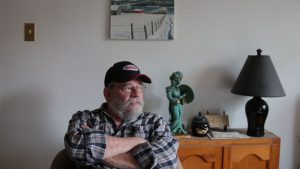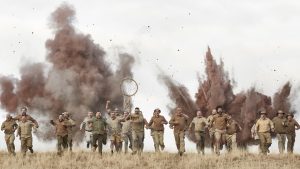Road Movies, Summer Hours And Tales Of Life And Death
in 27th Regard - Saguenay International Short Film Festival
by Pat Mullen
There was no shortage of innovation among the films at the 27th annual Regard: Saguenay Short Film Festival. Regard’s programming was especially notable for the strength of its documentaries. These films feature memorable characters, and stories told with artfully astute aesthetics that honor their subject’s perspectives and advance documentary form.
For example, the Dutch film Neighbour Abdi (Burrman Abdi), directed by Douwe Dijkstra, boldly advances subject-filmmaker collaboration. The film invites Somalian refugee Abdiwahab Ali to tell the story of his journey from Mogadishu, Somalia, to the Netherlands. As Abdi recounts his experience in a confessional interview, the film doesn’t feature a conventional direct address. Instead, Abdi generally looks off-camera as he tells Djikstra about violence on the streets of Mogadishu. Meanwhile, the visuals transport audiences to the streets of Mogadishu, where bloodshed is so normalized that children throw ducks at one another while gunfire explodes nearby. Pieces of concrete debris are the new baseballs.
The film beautifully energizes these streets by building them in miniature and making the dramatization of Abdi’s life part of the documentary’s design. Actors appear superimposed atop the miniature set after performing under Abdi’s direction before a green screen. As Abdi revisits his past through these dramatic recreations, he imparts the wisdom of his experience to a younger generation of Somali refugees. Moreover, as Dijkstra documents Abdi, the film empowers its subject through filmmaking while respecting the remove through which one director observes another. This dual feat of filmmaking is a worthy winner of Regard’s Jury Prize for Best Documentary Film.

Similarly, Regard’s Grand Prize winner for Best Canadian Film is also a documentary. While director Charles-Émile Lafrance’s The Thirty-Second Season (La trente-deuxième saison) is among the more aesthetically conservative films from this year’s festival, it delivers a rewarding character study thanks to its objective no-frills portrait. Lafrance observes his former neighbor, Normand, as the aging man comes to terms with the death of his long-time wife. Normand offers a great salt-of-the-earth character, and he surprises with his vulnerability. Lafrance finds a nuanced message of grief and letting go in Normand’s story.

Danish filmmaker Adam Paske, on the other hand, has a great deal of fun flipping the format of ethnographic cinema in Leisure Time – A Summer’s Day (En Dag I Sommerhus). The film follows the structure of a waking day as Danes repose in their summer homes. The film opens with a droll shot of a vacationer skipping jump rope in the nude, establishing the humor to come. Paske captures the routines of the vacationers by observing them in long takes, finding a few minutes throughout the day that show the habits people create for themselves during leisure hours. For example, a woman narrates her day to her dog while a young couple passes the hours in bend. The film’s measured cadence lends a dry sense of humor to the banality of these summer hours, yet finds refreshing comfort in the simple pleasures the characters enjoy, free from the stresses of the rat race. It’s a fine piece of observational cinema.
Summer hours also fuel the excellent documentary Oasis by Quebecois filmmaker Justine Martin. This poignant feat of cinema vérité drops audiences into the lives of brothers Raphaël and Rémi Cormier as they relish their holidays. The twins are inseparable, yet Martin finds a bittersweet parallel between their lives and the fading summer light. Rémi has a disability and isn’t maturing at the same rate as Raphaël. However, as Martin observes the boys, Oasis shows the strong bond between twins as Raphaël proudly assumes a protective role. Featuring gorgeous cinematography by Myriam Payette, Oasis, like Leisure Time, basks in the glow of the summer sun and captures the warmth of the natural light to convey the strength of the twins’ bond. This film’s portrayal of youth and innocence is profoundly intimate as it immerses viewers in the brothers’ relationship. One could easily mistake Oasis for a coming-of-age drama until an interview question from Martin, speaking off camera, reveals the documentary form. It beautifully conveys how these boys are everything to each other, capturing the idyllic innocence of summer hours in a world where nobody else seems to exist.

One sees another inspired take on family dynamics in Darcy Prendergast’s extraordinary film Strange Beasts. The darkly funny Australian doc tells the story of Prendergast’s zookeeper father, Ron, who narrowly escaped death amid the decline of the once-popular Bacchus Marsh Lion Safari. Ron recounts his traumatic experience of being mauled by a tiger when the zoo began cutting corners to save costs. The elder Prendergast has a natural flair as a storyteller, and the film smartly hinges on his skills as a raconteur as he brings the saga to an unexpected twist. Upon leaving the hospital, he discovered the same tiger had escaped from the safari, tracked him down, and mauled him again.
Strange Beasts, however, is far more than a novel family affair. Prendergast presents archival footage of the giant cats in action. Lions and tigers prowl through the film as the zookeeper speaks to the animals’ power, might, and charm. However, as the elder Prendergast tells his saga of cheating death not once but twice, his son finds an ironic tragedy as the tigers meet violent ends. Strange Beasts grows into an unexpected consideration of mortality, reminding audiences of life’s only other inevitability after taxes.
Another poetic consideration of mortality finally comes in Raquel Sancinetti’s poignant film Madeleine. The Quebecois film, winner of the FIPRESCI prize at Saguenay, is a moving story of friendship that spans generations. Sancinetti draws upon audio conversations with her 96-year-old subject, Madeleine, who reflects upon growing old. Madeleine tells her younger friend that she isn’t bothered to get outside much these days, but the filmmaker has a cunning plan. Madeleine employs excellent stop-motion animation to take the elderly subject on one last adventure. The film adopts the tropes of a road movie as Sancinetti and Madeleine, now in puppet form, drive to the beach.
Along the way, the film returns to vérité images of the real Madeleine as Sancinetti hands her the camera and asks her to film herself. These shots reveal Madeleine’s ongoing curiosity and playfulness, which Sancinetti evokes through the joyful animation. There’s a great sense of humor in the details of the storytelling, too, as Madeleine situates the trip amid the COVID-19 pandemic as background characters wear protective face covers and an errant mask flies through the car departs for the adventure. The timing of the story makes Sancinetti’s use of animation doubly profound. The film reminds us that elderly residents of long-term care facilities were subjected to incredibly arduous stretches of isolation during the pandemic. Sancinetti beautifully takes Madeleine into the world when lockdown measures confine her to her room. As Madeleine transports its subject on a voyage only animation could allow, it offers a beautiful journey of heart and humor as both women grow. Madeleine confronts her mortality, while Sancinetti accepts the stage she is at in her own life by drawing upon her companion’s indefatigable joie de vivre. Madeleine is a true coup de coeur and the highlight in a strong program at this year’s Regard – Saguenay Short Film Festival.
Pat Mullen
Edited by Anne-Christine Loranger
© FIPRESCI 2023
